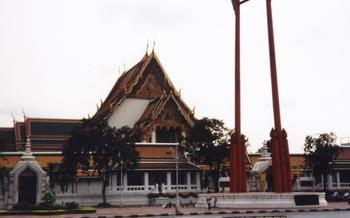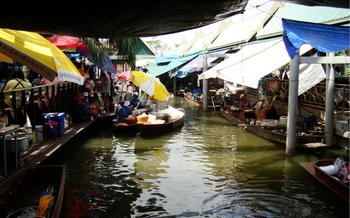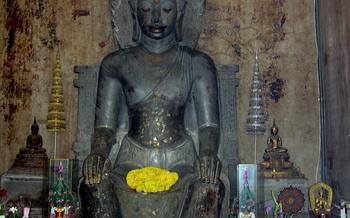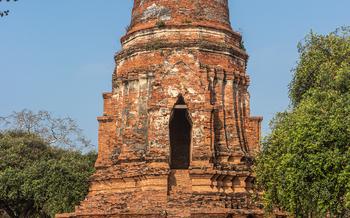
Wat Si Sawan Sangkharam
- The Ubosot: A Masterpiece of Architecture
- The Surrounding Grounds: A Place of Tranquility
- The Monks' Quarters: A Glimpse into Monastic Life
- The Temple's Festivals: A Celebration of Faith
- Visitor Information: Planning Your Visit
- Getting There: Convenient Transportation Options
- Accommodation: Nearby Hotels and Guesthouses
- Food and Drink: Local Delicacies to Savor
- Shopping: Unique Souvenirs and Handicrafts
- Photography Tips: Capturing the Temple's Beauty
- Respectful Travel: Etiquette and Customs
- Insider Tip: Hidden Gems and Local Secrets
The Ubosot: A Masterpiece of Architecture
The Ubosot at Wat Si Sawan Sangkharam is a stunning example of Thai temple architecture. Built in the Ayutthaya period, it is a testament to the skill and artistry of the craftsmen of that era.
One of the unique features of the Ubosot is its soaring roof, which is supported by intricate wooden beams and brackets. The roof is adorned with elaborate carvings depicting mythical creatures and scenes from Buddhist mythology.
The interior of the Ubosot is equally impressive, with its walls covered in colorful murals. These murals depict scenes from the life of Buddha, as well as stories from Thai history and mythology. The murals are a testament to the craftsmanship and attention to detail of the artists who created them.
The Ubosot is a sacred space for the monks of Wat Si Sawan Sangkharam. It is here that they gather for daily prayers and meditation. The Ubosot is also used for special ceremonies, such as ordinations and weddings.
The Surrounding Grounds: A Place of Tranquility
As you step outside the Ubosot, you will find yourself immersed in the serene and tranquil surroundings of Wat Si Sawan Sangkharam. Lush gardens, meticulously maintained by the monks, create a picturesque backdrop for your visit. The vibrant colors of blooming flowers, the gentle rustling of leaves in the breeze, and the melodious chirping of birds all contribute to the peaceful atmosphere of the temple.
The gardens are designed to promote a sense of calm and contemplation, inviting visitors to slow down, relax, and appreciate the beauty of nature. Pathways wind their way through the gardens, leading to hidden corners and secluded spots where you can sit and meditate, or simply enjoy the tranquility of the surroundings.
The temple's grounds also feature several ponds and water features, which add to the overall serenity of the environment. The gentle sound of water flowing creates a soothing ambiance, while the reflection of the temple buildings in the water adds a touch of magic to the landscape.
Whether you are seeking a place to escape the hustle and bustle of everyday life, or simply want to spend some time in quiet contemplation, the surrounding grounds of Wat Si Sawan Sangkharam offer a perfect sanctuary for peace and tranquility.
The Monks' Quarters: A Glimpse into Monastic Life
The monks' quarters at Wat Si Sawan Sangkharam offer a unique opportunity to gain insights into the daily lives of Buddhist monks. These quarters, typically located within the temple grounds, are where the monks reside, study, and practice their religious duties.
Daily Routines of the Monks
The monks at Wat Si Sawan Sangkharam follow a strict daily routine that revolves around meditation, prayer, and study. They typically wake up early in the morning, around 4 or 5 AM, and begin their day with meditation and chanting. After that, they engage in various activities such as cleaning the temple grounds, studying Buddhist scriptures, and conducting religious ceremonies. The monks also participate in alms-giving ceremonies, where they receive food offerings from the local community.
Importance of Discipline and Devotion
The monks' lives are characterized by discipline and devotion. They follow a set of rules and regulations that govern their behavior and conduct. These rules include observing celibacy, refraining from consuming alcohol and drugs, and maintaining a simple and humble lifestyle. The monks' devotion to their faith is evident in their dedication to their daily practices and their commitment to serving the community.
Interaction with Visitors
The monks at Wat Si Sawan Sangkharam are generally welcoming and open to interacting with visitors. They may engage in conversations about Buddhism, answer questions about the temple, or provide guidance on meditation and spiritual practices. Visitors are encouraged to show respect and humility when interacting with the monks and to observe the temple's rules and etiquette.
The Temple's Festivals: A Celebration of Faith
Wat Si Sawan Sangkharam comes alive during its annual festivals, which are a vibrant expression of faith and community spirit. The most significant festival is the Phra Buddhabat Festival, held in February or March each year. It commemorates the footprint of the Buddha, which is believed to be enshrined within the temple's main ordination hall. During this festival, the temple grounds are adorned with colorful decorations, and monks lead processions carrying sacred relics and images of the Buddha. Devotees from near and far flock to the temple to pay homage and participate in the festivities.
Another important festival is Songkran, the Thai New Year, which takes place in April. During Songkran, the temple organizes water-blessing ceremonies, where monks sprinkle holy water on devotees to bring good luck and prosperity. The temple grounds are transformed into a lively fair, with food stalls, games, and performances. Locals and visitors alike come together to celebrate, exchange gifts, and enjoy the festive atmosphere.
These festivals offer a unique opportunity to witness the deep devotion and cultural traditions of the Thai people. Visitors are welcome to participate in the festivities, but it is important to be respectful and mindful of local customs and etiquette.
Visitor Information: Planning Your Visit
Opening hours: Wat Si Sawan Sangkharam is open to visitors daily from 8 am to 5 pm. The temple's main prayer hall, the ubosot, is closed during religious ceremonies, which typically take place in the morning.
Admission fees: There is no admission fee to enter the temple. However, donations are welcome and help to support the temple's upkeep and maintenance.
Dress code and etiquette: Visitors to the temple are expected to dress respectfully. Shorts, tank tops, and revealing clothing are not appropriate. It is also customary to remove one's shoes before entering the ubosot.
Before entering the temple, visitors should take a moment to pay their respects to the Buddha images by bowing three times. It is also considered disrespectful to point one's feet at a Buddha image or to touch the head of a monk.
When interacting with the monks, visitors should be polite and respectful. It is customary to address monks as "phra" or "ajahn." Visitors should also avoid asking personal questions or engaging in conversation about controversial topics.
Getting There: Convenient Transportation Options
Reaching Wat Si Sawan Sangkharam is a breeze, with several convenient transportation options available to suit your travel preferences and budget.
For those seeking a scenic and immersive experience, a boat trip along the Ping River is highly recommended. The journey offers breathtaking views of the surrounding landscapes, allowing you to soak in the natural beauty of the region. Alternatively, if you prefer a more direct and efficient option, buses and taxis are readily available, providing a comfortable and reliable mode of transport to the temple.
No matter your choice, getting to Wat Si Sawan Sangkharam is a hassle-free process. The temple's accessibility and proximity to major cities like Bangkok and Chiang Mai make it an ideal destination for a day trip or as part of a larger itinerary exploring the wonders of Thailand. Whether you're a seasoned traveler or a first-time visitor, the journey to this sacred site promises to be both convenient and enjoyable.
Accommodation: Nearby Hotels and Guesthouses
There are several accommodation options available near Wat Si Sawan Sangkharam, catering to different budgets and preferences. For those seeking a luxurious stay, the Siri Nakhon Sawan Hotel offers elegant rooms and suites with modern amenities, while the Grand Center Point Hotel provides comfortable rooms with stunning city views.
For budget-conscious travelers, there are several guesthouses and hostels within walking distance of the temple. These options offer basic yet clean and comfortable accommodations, allowing visitors to save money on their stay. Some popular choices include the Nakhon Sawan Guesthouse and the Baan Thai Hostel, both of which offer friendly service and a welcoming atmosphere.
When choosing your accommodation, it is important to consider your budget, travel style, and proximity to the temple. If you are planning to spend a significant amount of time exploring the temple grounds, it may be convenient to stay at a hotel or guesthouse that is within walking distance. However, if you are on a tight budget, there are several affordable options located a short distance away that can be easily reached by public transportation or taxi.
Food and Drink: Local Delicacies to Savor
Nakhon Sawan offers a diverse culinary scene, and visitors to Wat Si Sawan Sangkharam can indulge in a variety of local delicacies.
-
Popular Dishes to Try: At nearby restaurants, visitors can savor classic Thai dishes such as Pad Thai, Som Tam (green papaya salad), and Khao Pad (fried rice). For a taste of local flavors, try Khao Soi, a northern Thai curry noodle soup, or Sai Krok Isan, a grilled sour sausage.
-
Vegetarian Options: Wat Si Sawan Sangkharam and the surrounding area cater to vegetarians with a range of meat-free options. Vegetarian Pad Thai, Tofu Som Tam, and Khao Pad Sapparot (pineapple fried rice) are widely available.
-
Recommended Restaurants: For an authentic dining experience, visitors can head to Somboon Seafood, known for its fresh seafood dishes, or Khao Soi Lamduan, famous for its delicious Khao Soi. For a more casual meal, Baan Rim Klong, located by the river, offers a relaxed ambiance and tasty Thai cuisine.
Shopping: Unique Souvenirs and Handicrafts
The area surrounding Wat Si Sawan Sangkharam is a treasure trove of unique souvenirs and handicrafts that reflect the rich cultural heritage of Nakhon Sawan. From traditional Thai clothing and accessories to intricate wood carvings and ceramic ware, there's something for every taste and budget.
Local Markets and Shops
The bustling local markets of Nakhon Sawan are the best places to find authentic souvenirs and handicrafts. The morning market, held daily along the Yom River, is particularly popular for its wide variety of goods, including fresh produce, handmade textiles, and local handicrafts. The night market, located near the city center, offers a more vibrant atmosphere, with food stalls, live music, and a wide range of souvenirs to choose from.
Traditional Thai Handicrafts
Nakhon Sawan is renowned for its traditional Thai handicrafts, many of which are produced by local artisans using techniques passed down through generations. Visitors can find beautiful hand-woven silk and cotton textiles, intricate silver jewelry, and exquisite wood carvings depicting scenes from Thai mythology and history.
Bargaining Tips
Bargaining is a common practice in Thailand, and it's perfectly acceptable to haggle with vendors over the price of souvenirs. However, it's important to do so politely and respectfully. Start by offering a price that is about half of the asking price, and be prepared to negotiate back and forth until you reach an agreement that is fair for both parties.
Photography Tips: Capturing the Temple's Beauty
Whether you're a seasoned photographer or simply enjoy capturing special moments, Wat Si Sawan Sangkharam offers plenty of opportunities for stunning images. Here are a few tips to help you make the most of your photography experience:
-
Best Time of Day for Photography: The best time to photograph the temple is during the early morning or late afternoon, when the light is soft and golden. This will help you capture the intricate details of the architecture and the vibrant colors of the murals.
-
Recommended Camera Settings: Use a tripod to stabilize your camera and avoid blurry photos. Set your camera to a low ISO to minimize noise and ensure sharp images. For the best depth of field, use a small aperture such as f/8 or f/
-
Composition and Angles: Experiment with different angles to create dynamic and interesting compositions. Try shooting from a low angle to emphasize the grandeur of the temple, or from a high angle to capture the surrounding landscape. Don't be afraid to move around and explore different perspectives.
Respectful Travel: Etiquette and Customs
When visiting Wat Si Sawan Sangkharam, it is essential to be mindful of local customs and traditions to ensure a respectful and enjoyable experience. Here are some guidelines to follow:
- Dress appropriately: Visitors should dress modestly and conservatively, covering their shoulders and knees. Avoid wearing shorts, tank tops, or revealing clothing.
- Remove your shoes: Before entering the temple grounds, remove your shoes and place them neatly on the designated racks.
- Be respectful of the monks: Monks are highly revered in Thai culture. When greeting a monk, wai (a traditional Thai gesture of respect) with your hands together in a prayer position and a slight bow. Avoid touching or making physical contact with monks.
- Speak softly and maintain silence: The temple is a place of worship and meditation, so it is essential to maintain a peaceful and respectful atmosphere. Speak softly and avoid loud noises or disruptive behavior.
- Ask permission before taking photos: While photography is generally allowed within the temple grounds, it is always advisable to ask for permission before taking photos of monks or other visitors.
- Be mindful of your behavior: Remember that the temple is a sacred place, so be mindful of your behavior and actions. Avoid engaging in inappropriate or disrespectful activities.
Insider Tip: Hidden Gems and Local Secrets
Beyond the main attractions, Wat Si Sawan Sangkharam holds hidden gems waiting to be discovered. Explore the temple's serene gardens, where you'll find secluded corners perfect for meditation and reflection. Take your time to admire the intricate details of the temple's architecture, from the delicate carvings on the ubosot's doors to the colorful murals that adorn the walls.
Engage with the friendly monks to learn about their daily routines and the history of the temple. They may even share some fascinating stories and insights into the local culture. If you're fortunate, you might witness a traditional Buddhist ceremony or chanting session, a truly immersive experience that offers a glimpse into the spiritual heart of the temple.
Venture off the beaten path to discover lesser-known areas of the temple complex. Wander through the peaceful monk's quarters, where you can observe their daily activities and gain a deeper understanding of monastic life. You might even catch a glimpse of the monks practicing meditation or chanting sutras.
To truly immerse yourself in the local culture, consider visiting the temple during one of its festivals. These vibrant celebrations, often held during the Thai New Year or other significant religious occasions, showcase the community's deep devotion and cultural heritage. Experience the colorful processions, traditional performances, and lively markets that bring the temple and the surrounding area to life.





